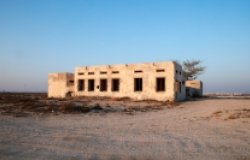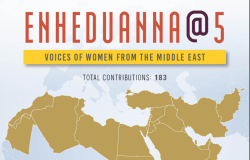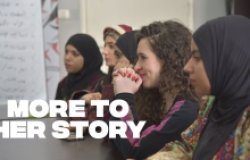
A blog of the Middle East Women's Initiative
COP, Gender Quotas, and Policies: Implications for the MENA Region and Beyond
Dina Najjar and Kamaldeen Mohammed review women’s participation in the COP meetings over the last decade and explain why greater women’s participation in climate governance is critical for achieving a sustainable planet and livelihoods.
The participation of women in the COPs and the associated climate change decisions are essential because they generate more effective and sustainable climate change policy outcomes.
Recently, we reflected on the outcomes of the 28th Conference of Parties (COP) meetings for gender policy. The annual COP represents the decision-making arm of the United Nations Framework Convention on Climate Change (UNFCCC), whose core mandate is to review and assess the measures taken by parties and progress made in achieving stabilization of greenhouse gas emissions globally. The most recent COP, held in Dubai, UAE, was the largest gathering so far, with about 85,000 participants in total, including more than 150 heads of state and governments.
Drawing on best practices identified in our recent policy brief and strategic review on strengthening women's participation in climate governance and resilience to climate change (undertaken by the International Center for Agriculture Research in the Dry Areas and Western University under the auspices of Her Plus Initiative), we discuss the participation of women in COP and related actions and specific policies related to gender emerging from COP28. Supporting women to assume leadership roles can result in increased investments for the services women prioritize and increase political engagement of women citizens more generally.
Trends in women's participation
Women’s participation at COP has remained intransigently low; however, this also differs by region. Their involvement tends to be highest among Latin American, Eastern European, and Western European delegations—usually ranging from 45% to 50%—with the lowest levels of participation in African and Asian delegations—often ranging from 30% to 35%.
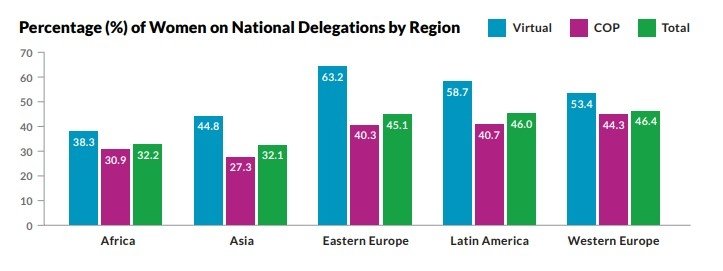
Similarly, the percentage of heads of delegations in COP meetings who were women increased from just 10% in 2009 to 13% in 2021, with a decrease of 9% in 2015, and the highest being 26% in 2017. According to the Women’s Environment and Data Organization (WEDO), gender equality in national COP delegations will not be achieved until 2040, and gender equality in COP heads of delegation will not be achieved anytime in the immediate future.
At COP28, the gender composition for delegations was 62% men to 38% women. Another report by WEDO indicates that 34% of women participated in COP28, the same as 10 years ago, indicating a stagnant number of women participating in the various COPs. There has been a 1% decrease in women’s participation from 11,955 women party delegates in COP27 to 9,731 women party delegates in COP28. However, 63% of the organizing committee members for COP28 were women, according to the Guardian.
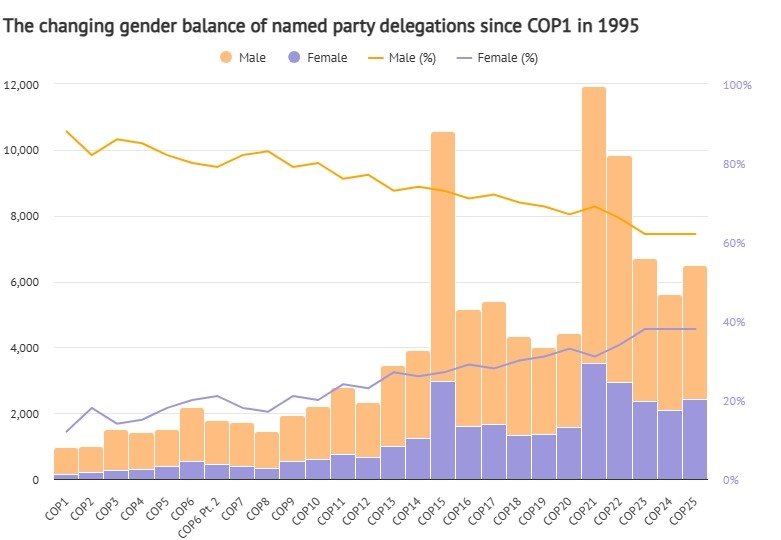
UNFCCC and Carbon Brief analysis
Do quotas work?
For more sustainable change, policies must seek to integrate gender in national climate change policies and initiatives, especially in Asia and Africa. While there is sustained focus on counting women's representation, quotas should not be limited to the 'quantitative' inclusion of women but must include ‘qualitative inclusion,’ meaning women must be in positions that contribute to decision-making. The participation of women at COPs and the associated climate change decisions are essential because they generate more effective and sustainable climate change policy outcomes.
Critiquing women’s low participation seems to work, as seen through the recent pressure on Azerbaijan to increase the number of women in COP29. When Azerbaijan announced that the organizing committee for COP29 constituted 28 men and no women, criticism mounted, leading to the addition of 12 women to the Azerbaijani delegation.
Quotas, when effective, can be vital in overcoming deeply entrenched cultural and social barriers that prevent women from participating fully in political and economic endeavours. A progressive approach to quotas can lead to equity in climate change and environmental sustainability.
What about MENA?
COP28 was the second consecutive COP meeting to be held in the Middle East and North Africa (MENA) region. Capitalizing on this vital moment, the MENA Feminist Task Force, serving as link between international community and the needs of women and girls, developed six climate action priorities—including climate finance, peacebuilding, climate education, inclusive climate governance, and just energy transition—to be incorporated into global climate processes and decisions. These priority areas emphasize mainstreaming gender equity in climate change policies and mitigating gender-based violence that is inherent in climate-induced disasters and conflicts.
Beyond participation, COP28 has implications for amplifying women-led climate solutions that enhance sustainable livelihoods. There were calls to increase funding flows to women in regions of high vulnerability, including MENA. Such gender-responsive climate initiatives promote women's empowerment and can be an effective strategy for tackling climate change stressors.
The Enhanced Lima Work Programme on Gender (ELWPG) was yet another product of COP28, with vital implication for gender policy. Specifically, the final review of its implementation focused on tracking the program’s progress, challenges, and priorities going forward. Building on COP28, the presidency also launched the Gender Responsive Just Transitions & Climate Action Partnership endorsed by 68 parties. The partnership aims to strengthen financial commitments, gender data, and equal opportunities.
Next steps: intersectional action
There is an acknowledgement that women’s participation was unequal at COP28. What seems to be missing in this conversation is intersectionality. Women have multiple sociocultural and economic identities mediating their adverse experience with climate change and their capacities to adapt. As such, there should be a conversation on improving not just women’s participation in COP overall but the diversity of women as well, including often neglected rural women from MENA and sub-Saharan Africa who are among the most vulnerable to our climate crises.
The views expressed in this piece are those of the authors and do not express the official position of the Wilson Center.
About the Authors

Middle East Program
The Wilson Center’s Middle East Program serves as a crucial resource for the policymaking community and beyond, providing analyses and research that helps inform US foreign policymaking, stimulates public debate, and expands knowledge about issues in the wider Middle East and North Africa (MENA) region. Read more

Middle East Women's Initiative
The Middle East Women's Initiative (MEWI) promotes the empowerment of women in the region through an open and inclusive dialogue with women leaders from the Middle East and continuous research. Read more



